Rogers Communications Bundle
Can Rogers Communications Maintain Its Momentum?
The Canadian telecommunications sector witnessed a monumental shift with Rogers Communications' acquisition of Shaw Communications, a move that redefined the industry's competitive landscape. This strategic consolidation, finalized in April 2023, highlights Rogers' ambitious growth strategy and its commitment to market dominance. Founded in 1960, Rogers has evolved from a pioneering vision to a leading communications and media powerhouse.
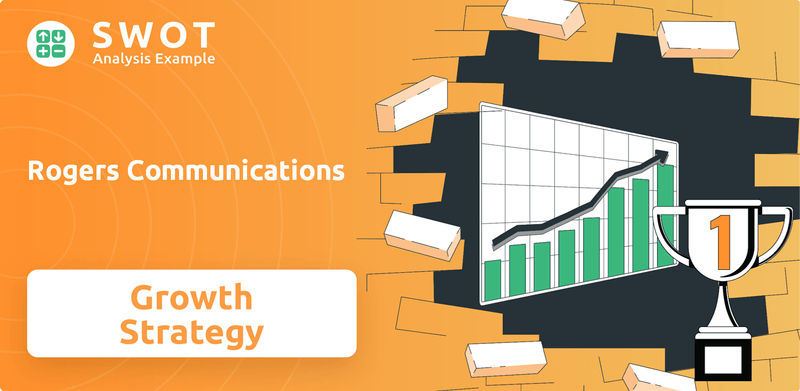
From its early days, Rogers has expanded its Rogers Communications SWOT Analysis, offering wireless, cable, internet, and home phone services. The company's extensive media holdings further solidify its position as a diversified giant in the Canadian telecom market. Analyzing Rogers' future involves understanding its strategic initiatives, including its 5G rollout strategy and customer acquisition strategies, which are vital for sustained revenue growth. Understanding the competitive landscape and navigating challenges will be crucial for Rogers' long-term vision and its impact on the Canadian economy.
How Is Rogers Communications Expanding Its Reach?
The expansion initiatives of Rogers Communications are largely shaped by its significant acquisition of Shaw Communications. This strategic move, finalized in April 2023, has significantly broadened its reach and infrastructure, impacting the growth strategy and future prospects of Rogers Communications. The integration of Shaw's assets has allowed Rogers to extend its wireline services, including internet and cable, into Western Canada, complementing its existing wireless services across the country.
This expansion is crucial for Rogers to enhance its 5G network deployment and provide higher-speed internet services to a larger geographic area. The acquisition also strengthens Rogers' competitive position within the Canadian telecommunications industry. The company is focused on organic growth through continued investment in its 5G network and exploring new business models.
Beyond the Shaw acquisition, Rogers is focused on organic growth through continued investment in its 5G network. The company aims to achieve 5G standalone (SA) network coverage across Canada, which will enable new services and applications, particularly for enterprise customers requiring ultra-low latency and high reliability. This includes exploring new business models such as fixed wireless access (FWA) to bring high-speed internet to underserved rural areas, leveraging its extensive wireless infrastructure.
The integration of Shaw's fiber-optic network is a key element of Rogers' expansion strategy. This integration enhances the company's ability to provide high-speed internet and expand its 5G network. The acquisition has increased Rogers' subscriber base and expanded its service offerings across Canada. This strategic move is pivotal for Rogers' long-term growth and competitive advantage.
Rogers is heavily investing in its 5G network to enhance coverage and capacity. The company aims to achieve 5G standalone (SA) network coverage across Canada. This expansion is designed to improve service quality and support new applications for both consumer and enterprise customers. The ongoing investment in 5G is a core part of Rogers' growth strategy.
Rogers is exploring the use of Fixed Wireless Access (FWA) to bring high-speed internet to underserved rural areas. FWA leverages Rogers' existing wireless infrastructure to provide internet access without the need for physical cables. This initiative aims to expand Rogers' reach and address the digital divide in remote regions. This is a key part of the company's customer acquisition strategies.
Rogers is actively pursuing partnerships to enhance its service offerings and expand its reach. One notable partnership is with SpaceX's Starlink to bring satellite-to-cell service to Canada. This collaboration targets remote areas without traditional cellular coverage. These strategic partnerships are designed to diversify revenue streams and improve customer experience.
Rogers Communications' expansion strategy involves several key initiatives aimed at strengthening its market position and improving its financial performance. These initiatives include the integration of Shaw Communications, the expansion of its 5G network, and strategic partnerships. These efforts contribute to Rogers' long-term vision and its impact on the Canadian economy.
- Integration of Shaw Communications: This has broadened Rogers' customer base and infrastructure.
- 5G Network Expansion: Ongoing investment to enhance coverage and improve service quality.
- Fixed Wireless Access (FWA): Bringing high-speed internet to underserved rural areas.
- Strategic Partnerships: Collaborations to diversify revenue streams and improve customer experience.
Rogers Communications SWOT Analysis
- Complete SWOT Breakdown
- Fully Customizable
- Editable in Excel & Word
- Professional Formatting
- Investor-Ready Format
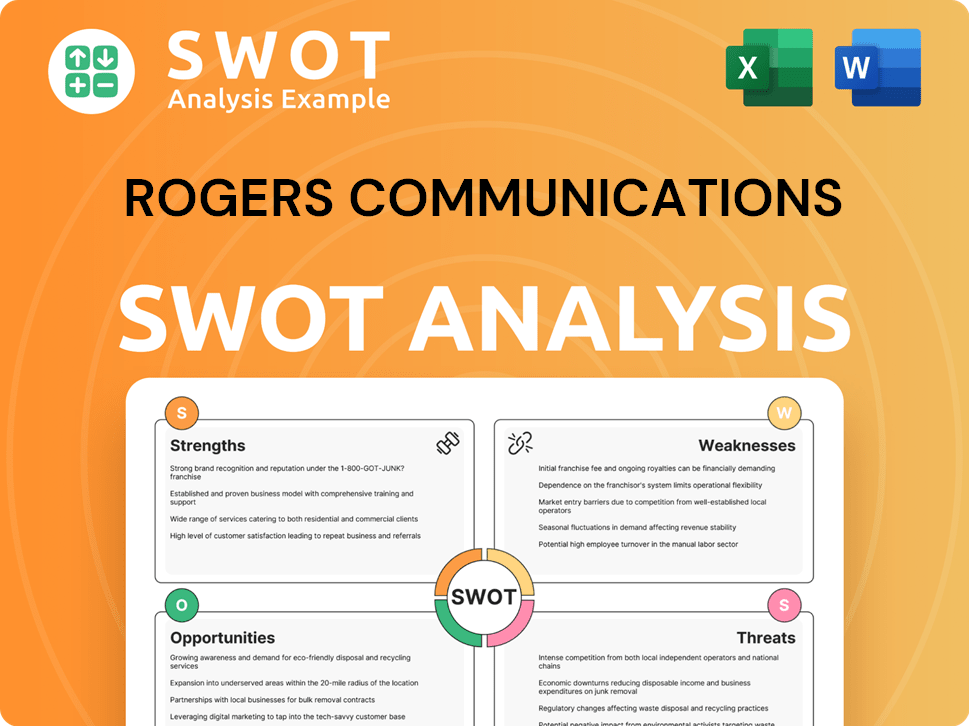
How Does Rogers Communications Invest in Innovation?
Rogers Communications is deeply invested in innovation and technology to foster sustained growth. The company's strategy heavily relies on its 5G network and digital transformation initiatives. Substantial investments in research and development (R&D) are directed towards expanding and enhancing 5G capabilities.
This commitment is evident in the continuous upgrades and expansion of its network, which are essential for supporting new applications and services. Rogers aims to maintain a competitive edge in the telecommunications industry by leveraging cutting-edge technologies.
Rogers is also focused on digital transformation to improve operational efficiency and customer experience. This includes automating processes and enhancing self-serve options for customers. The company is exploring advanced technologies like Artificial Intelligence (AI) and the Internet of Things (IoT) to develop new products and platforms.
Rogers is actively expanding its 5G network across Canada. The goal is to provide faster and more reliable connectivity to its customers. This expansion is crucial for supporting the increasing demand for data and advanced services.
The company is undergoing a digital transformation to improve operational efficiency. This includes implementing automation and enhancing customer self-service options. The use of data analytics is also a key part of personalizing services.
Rogers is exploring the use of Artificial Intelligence (AI) and the Internet of Things (IoT). These technologies are being used to develop new products and platforms. This includes smart city solutions and connected vehicle technologies.
Rogers is collaborating with companies like SpaceX for satellite-to-cell technology. This innovation aims to provide connectivity in challenging environments. This is a key part of the company's commitment to innovative solutions.
Rogers is making significant R&D investments to enhance its 5G capabilities. These investments are focused on developing a standalone 5G network. This network will offer lower latency and higher bandwidth.
The company is developing enterprise solutions leveraging 5G and other advanced technologies. These solutions are designed to meet the specific needs of businesses. This includes enhanced connectivity and data analytics.
These technological advancements are central to Rogers' Growth Strategy, enabling it to offer advanced services and maintain its competitive position. The focus on 5G SA is expected to unlock new opportunities for IoT applications that require real-time data processing and connectivity. For a deeper dive into the company's financial structure and revenue streams, consider reading about the Revenue Streams & Business Model of Rogers Communications.
Rogers' technology strategy focuses on several key initiatives to drive growth and enhance its market position within the Canadian Telecom sector. These initiatives are designed to improve customer experience and operational efficiency.
- 5G Network Rollout: Continuous expansion and upgrades of the 5G network to increase coverage and capacity.
- Digital Transformation: Implementing automation and data analytics to streamline operations and personalize customer services.
- AI and IoT Applications: Developing new products and platforms in areas such as smart cities and connected vehicles.
- Satellite-to-Cell Technology: Partnering with companies like SpaceX to provide connectivity in remote areas.
- Enterprise Solutions: Offering advanced connectivity and data analytics solutions tailored for business needs.
Rogers Communications PESTLE Analysis
- Covers All 6 PESTLE Categories
- No Research Needed – Save Hours of Work
- Built by Experts, Trusted by Consultants
- Instant Download, Ready to Use
- 100% Editable, Fully Customizable
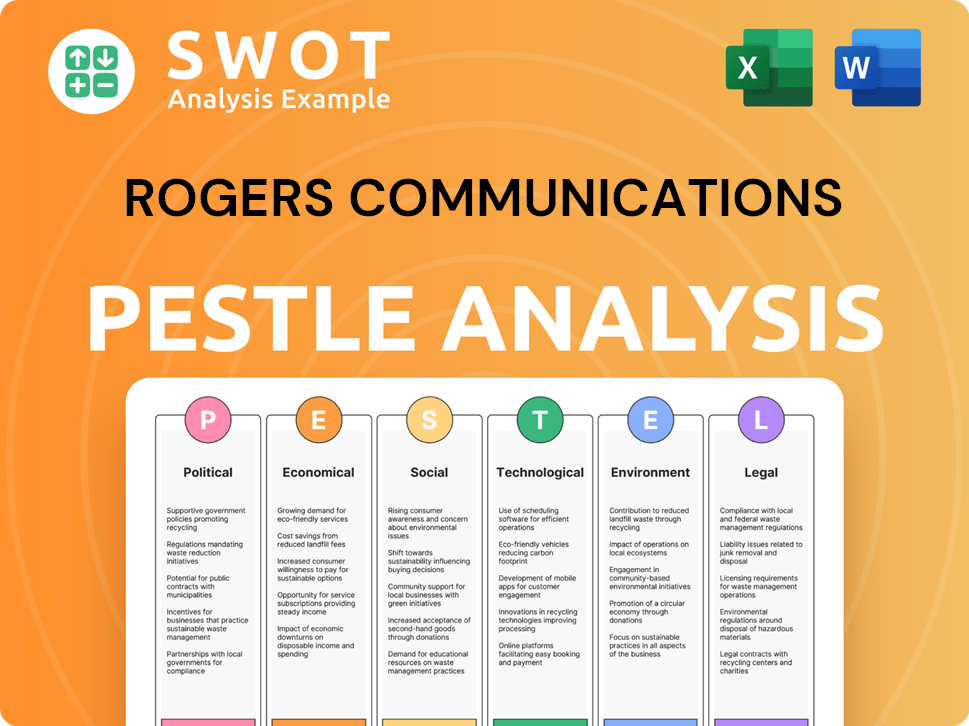
What Is Rogers Communications’s Growth Forecast?
The financial outlook for Rogers Communications is robust, driven by strategic initiatives and the integration of Shaw Communications. For the full year 2024, the company anticipates strong growth across key financial metrics. This positive trajectory is supported by investments in network infrastructure and robust subscriber growth in both wireless and internet segments, solidifying its position within the Canadian telecommunications industry.
Rogers Communications' financial strategy focuses on leveraging synergies from the Shaw acquisition to enhance operational efficiency and revenue expansion. The company aims to maintain healthy profit margins while investing in growth areas, demonstrating a commitment to sustainable financial performance. These efforts are crucial for navigating the competitive landscape and achieving long-term value creation for stakeholders, reflecting the company's strategic initiatives.
In the first quarter of 2024, Rogers reported a 6% increase in total revenue and a 12% increase in adjusted EBITDA, showcasing positive momentum. The company's long-term financial goals include deleveraging its balance sheet and generating strong free cash flow to support future investments and shareholder returns. These financial ambitions are aligned with industry benchmarks, signaling a commitment to sustainable growth and value creation, which is critical for Rogers' future.
Rogers projects total service revenue growth of 8% to 10% for the full year 2024. This growth is a key indicator of the company's success in the telecommunications industry. The company's strategic initiatives are designed to drive revenue and market share.
Adjusted EBITDA is expected to grow by 11% to 13% in 2024. This reflects the company's ability to improve profitability through operational efficiencies and revenue growth, which is crucial for Rogers' future.
Capital expenditures are forecasted to be between $2.8 billion and $3.0 billion. These investments are primarily focused on network infrastructure, including 5G deployment and fiber upgrades. This demonstrates the company's commitment to innovation and technology.
The company is concentrating on leveraging synergies from the Shaw acquisition. This includes cost efficiencies and revenue expansion, which are expected to contribute significantly to overall financial performance. This is a key part of the Rogers growth strategy.
Robust subscriber growth across wireless and internet segments supports the financial outlook. This growth is a key driver of revenue and profitability. Customer acquisition strategies are essential for Rogers' success.
Rogers aims to maintain healthy profit margins by optimizing operational costs. This focus on efficiency is crucial for long-term financial health. The company is committed to sustainable growth.
The company's long-term financial goals include deleveraging its balance sheet. Generating strong free cash flow will support future investments and shareholder returns. This will help Rogers achieve its long-term vision.
These financial ambitions are aligned with industry benchmarks for leading telecommunications providers. This alignment signals a commitment to sustainable growth and value creation. This is a key factor in the Rogers competitive landscape.
Continued investment in network infrastructure, particularly 5G deployment and fiber upgrades, is a priority. These investments are crucial for providing advanced services and maintaining a competitive edge. This is part of the Rogers 5G rollout strategy.
The company's financial performance and strategic initiatives have a significant impact on the Canadian economy. This includes job creation, technological advancement, and economic growth. This is part of the Rogers long-term vision.
Rogers Communications Business Model Canvas
- Complete 9-Block Business Model Canvas
- Effortlessly Communicate Your Business Strategy
- Investor-Ready BMC Format
- 100% Editable and Customizable
- Clear and Structured Layout
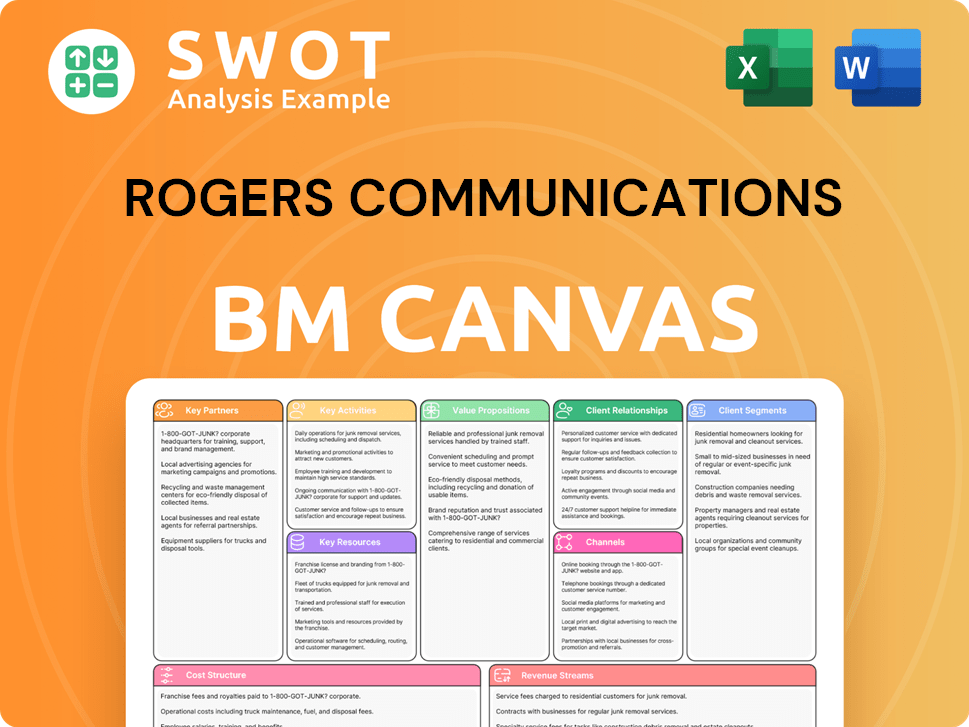
What Risks Could Slow Rogers Communications’s Growth?
Several potential risks and obstacles could impede the growth strategy of Rogers Communications. The company faces intense competition in the telecommunications industry, along with constant technological disruptions and regulatory changes. These challenges could affect Rogers Communications's ability to maintain and expand its market share and financial performance.
Market competition is a significant hurdle, with established players and emerging competitors vying for market share across wireless, internet, and media services. Regulatory changes also pose a continuous risk, particularly in the Canadian telecom sector, where government policies can directly influence business operations and investment decisions. Furthermore, technological advancements and supply chain vulnerabilities could impact service deployment and product availability.
Internal resource constraints, such as the availability of skilled labor, could also hinder the pace of growth. Addressing these challenges requires strategic initiatives focused on innovation, customer acquisition, and operational efficiency. Understanding these risks is crucial for investors and stakeholders assessing Rogers Communications's long-term vision and impact on the Canadian economy.
The Canadian telecommunications industry is highly competitive, with major players like Bell and Telus. Smaller providers also compete, creating pricing pressures and potentially increasing customer churn rates. The competitive landscape necessitates continuous innovation and strategic initiatives to maintain market share.
Regulatory policies, including those concerning spectrum allocation and foreign ownership, can significantly affect Rogers Communications. Conditions imposed during the Shaw acquisition highlight the impact of regulatory bodies. Compliance with these regulations is crucial for business operations and investment decisions.
Rapid advancements in areas like satellite internet and new wireless technologies could shift consumer preferences. Over-the-top (OTT) content services pose a threat to traditional revenue streams. Rogers must continuously invest in infrastructure and explore new partnerships to mitigate these risks.
Supply chain issues for network equipment and consumer devices can impact service deployment and product availability. Rogers addresses these risks through supplier diversification and proactive inventory management. The ability to secure essential components is critical for maintaining service quality.
The availability of skilled labor for network deployment and technological innovation could hinder growth. Attracting and retaining top talent and investing in employee training are key strategies. Overcoming these internal challenges is crucial for sustaining growth.
Changes in economic conditions, such as inflation or interest rate fluctuations, can affect Rogers Communications's financial performance. These macroeconomic factors can impact consumer spending and investment decisions. Managing financial risks is crucial for long-term success. For more insights, explore the Target Market of Rogers Communications.
Rogers Communications competes with major players such as Bell and Telus for market share. In the wireless segment, the company's market share was approximately 32% in 2024, facing pressures from aggressive pricing strategies by competitors. The company’s internet services also face stiff competition, with a focus on expanding its fiber-optic network to maintain competitiveness.
Rogers has been investing heavily in its 5G network rollout and expanding its fiber-optic infrastructure. These investments are aimed at improving network capacity and enhancing customer experience. Strategic partnerships, such as the one with SpaceX for satellite-to-cell service, are also key to expanding coverage in remote areas, which is crucial for revenue growth drivers.
In 2024, Rogers Communications reported a revenue increase of approximately 3% year-over-year, driven by growth in its wireless and internet services. However, the company faces challenges, including rising operational costs and increased capital expenditures for network upgrades. The company's stock price forecast has been influenced by these factors, with analysts projecting moderate growth.
One of the main challenges is maintaining profitability in a highly competitive market. Opportunities include expanding into new technologies and services, such as smart home solutions and IoT. The company is also focused on sustainability initiatives to improve its environmental footprint, which is crucial for long-term vision and attracting environmentally conscious investors.
Rogers Communications Porter's Five Forces Analysis
- Covers All 5 Competitive Forces in Detail
- Structured for Consultants, Students, and Founders
- 100% Editable in Microsoft Word & Excel
- Instant Digital Download – Use Immediately
- Compatible with Mac & PC – Fully Unlocked
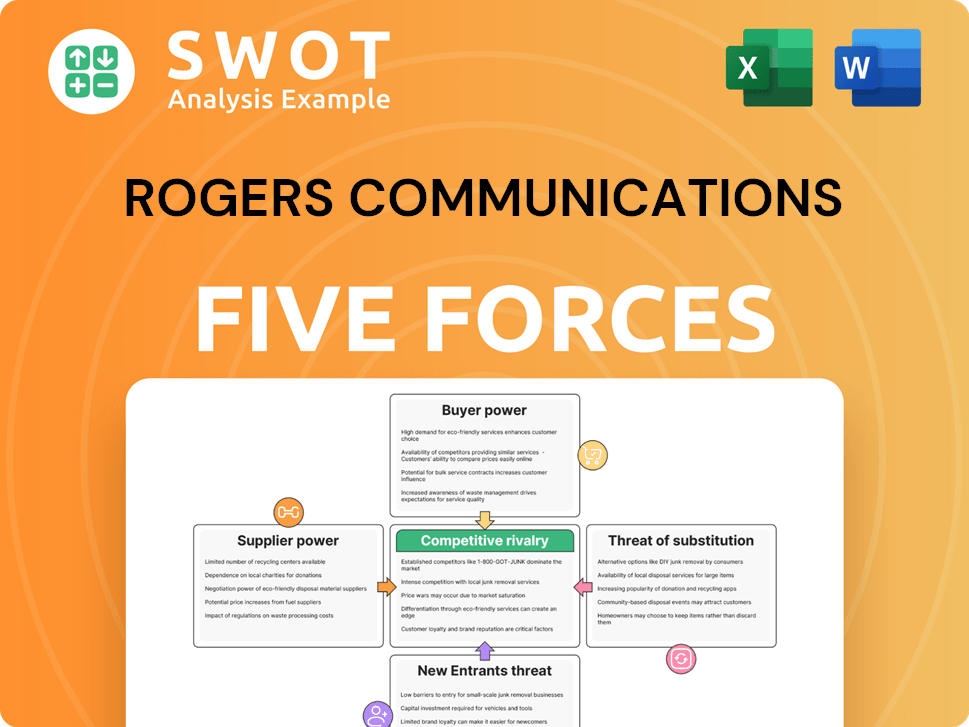
Related Blogs
- What are Mission Vision & Core Values of Rogers Communications Company?
- What is Competitive Landscape of Rogers Communications Company?
- How Does Rogers Communications Company Work?
- What is Sales and Marketing Strategy of Rogers Communications Company?
- What is Brief History of Rogers Communications Company?
- Who Owns Rogers Communications Company?
- What is Customer Demographics and Target Market of Rogers Communications Company?
Disclaimer
All information, articles, and product details provided on this website are for general informational and educational purposes only. We do not claim any ownership over, nor do we intend to infringe upon, any trademarks, copyrights, logos, brand names, or other intellectual property mentioned or depicted on this site. Such intellectual property remains the property of its respective owners, and any references here are made solely for identification or informational purposes, without implying any affiliation, endorsement, or partnership.
We make no representations or warranties, express or implied, regarding the accuracy, completeness, or suitability of any content or products presented. Nothing on this website should be construed as legal, tax, investment, financial, medical, or other professional advice. In addition, no part of this site—including articles or product references—constitutes a solicitation, recommendation, endorsement, advertisement, or offer to buy or sell any securities, franchises, or other financial instruments, particularly in jurisdictions where such activity would be unlawful.
All content is of a general nature and may not address the specific circumstances of any individual or entity. It is not a substitute for professional advice or services. Any actions you take based on the information provided here are strictly at your own risk. You accept full responsibility for any decisions or outcomes arising from your use of this website and agree to release us from any liability in connection with your use of, or reliance upon, the content or products found herein.